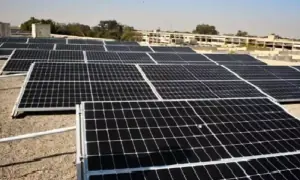Pakistan vulnerable to climate change: World Bank
Pakistan is highly vulnerable to worsening climate change; building resilience is key to avoiding poverty increases, otherwise there is a significant probability of more frequent and intense events such as droughts, floods, and sea level rise.
This was disclosed by a World Bank delegation led by Regional Director for Sustainable Development South Asia, John A. Roome, who met Sindh Chief Minister Murad Ali Shah at CM House. The meeting was attended by ministers, the chief secretary, the chairman for planning and development.
Roome said Pakistan’s recent poverty reduction was fragile due to macro-fiscal vulnerabilities and low and volatile growth.
The WB report said that the reduced extreme poverty due to off-farm economic and foreign remittances, growth in per capita GDP has been volatile and low. The structural issues, including circular debt, large and unproductive subsidy regimes, and inadequate tax collection adds to fiscal stress and constrained investment in human capital, basic infrastructure, and services.
According to the report, Pakistan has been a low GHG emitter, but there are opportunities in Pakistan’s own interests to decarbonize the economy. Pakistan contributed less than one percent of total Green House Gases emissions between 1990 and 2018. The GHG emissions per capita are low, about one-third of the global average. GHG emissions per GDP are decreasing but at a lower rate than the global average. The GHG emissions are growing fast due to population increases and economic growth, therefore focus may be made to significant decarbonization options in industry, power, and transport that deliver local co-benefits.
According to the report, the 2022 floods will likely hamper progress toward the achievement of the Sustainable Development Goals (SDGs) in Pakistan by 2030. Some 8.4 to 9.1 million people would be pushed into poverty, and 6 to 7 million people would fall further behind. An additional 7.6 million people face food insecurity, 17 million women and children are at greater risk of preventable diseases, 4.3 million people would face job loss or disruption and 640,000 women and girls are at risk of GBV and child marriage.
Post-flood recovery: The post-flood presents a significant opportunity for building long-term and systematic resilience. The report suggests that an inclusive and resilient recovery through a whole Pakistan approach leads to sustainable development for the people and country. The pillars of the recovery, according to the report, include the restoration of jobs and livelihoods, recovery and reconstruction of critical assets, services, and infrastructure, and strengthening government and stakeholder capacity for reconstruction, especially communities.
Building resilience to these compound risks will require a strong pivot of the economy towards a development pathway that can sustain and strengthen equitable growth and limit the impact of climate change-related physical, transitional, and financial risks.
The chief minister directed his P&D team to study the WB report and recommendations and then frame its own development plan in light of the report so that the province could be steered out of poverty through sustainable development.
For the latest news, follow us on Twitter @Aaj_Urdu. We are also on Facebook, Instagram and YouTube.















Comments are closed on this story.